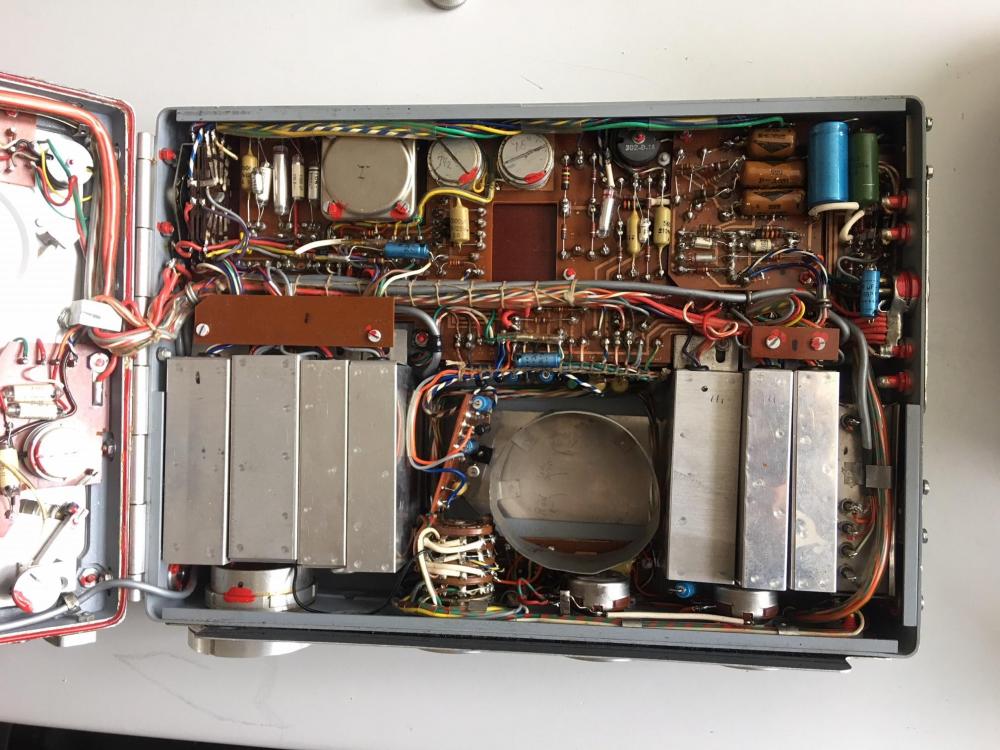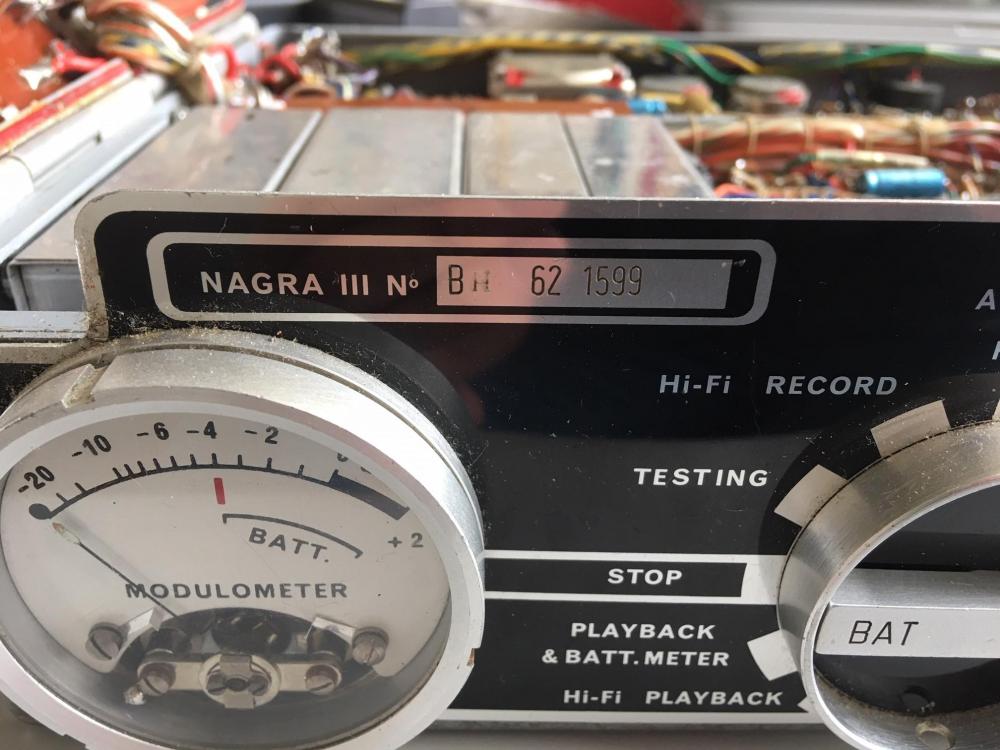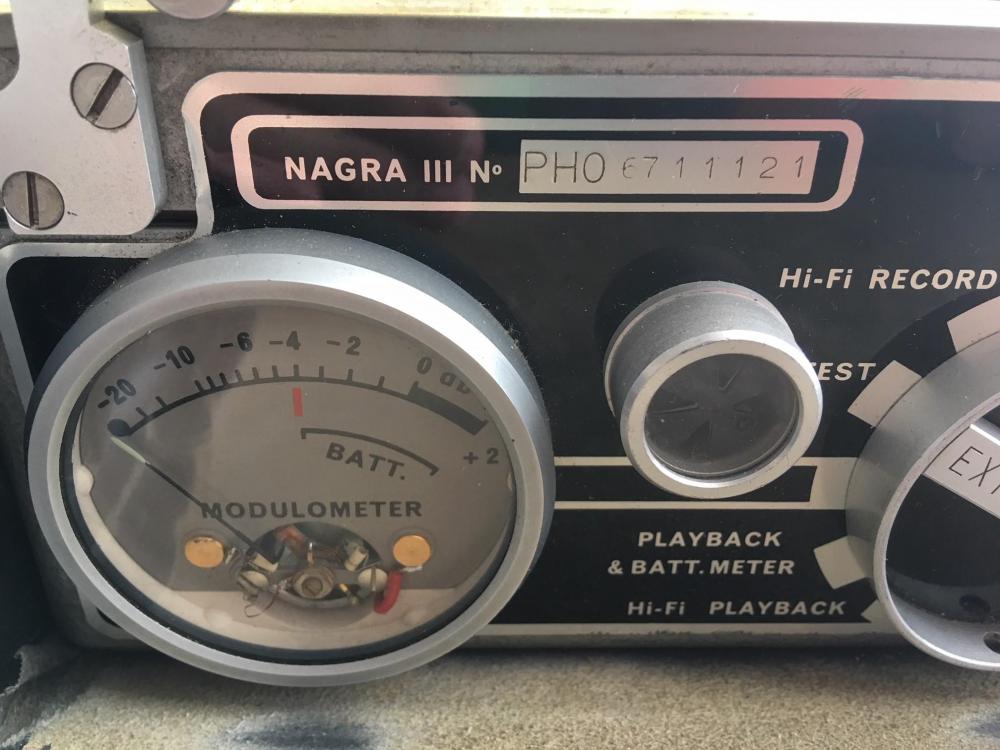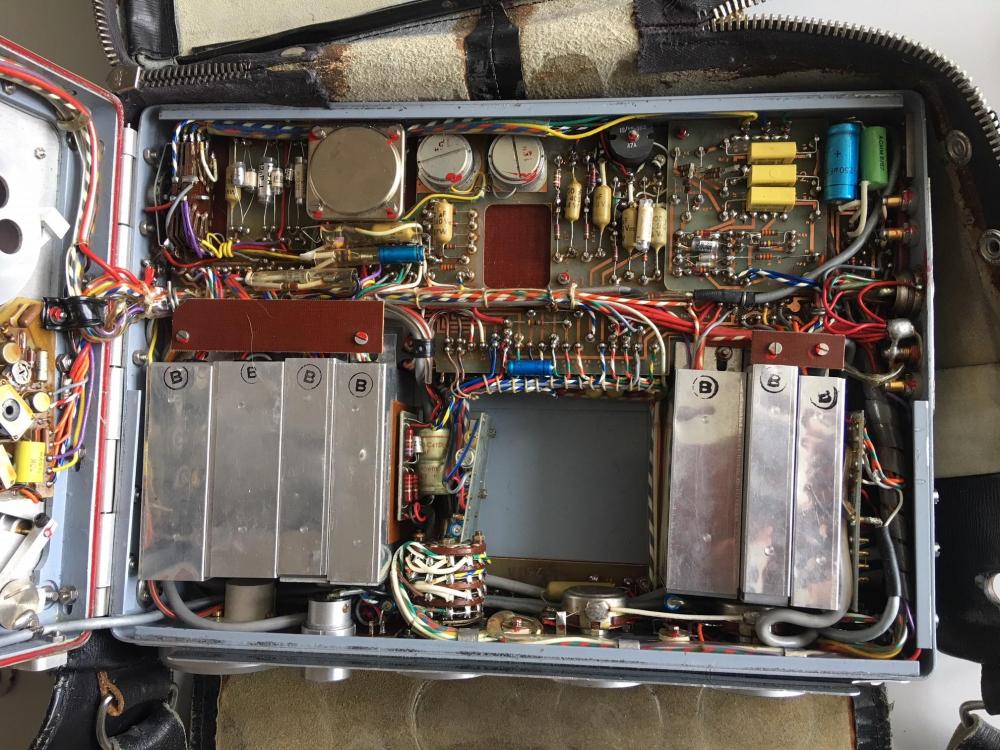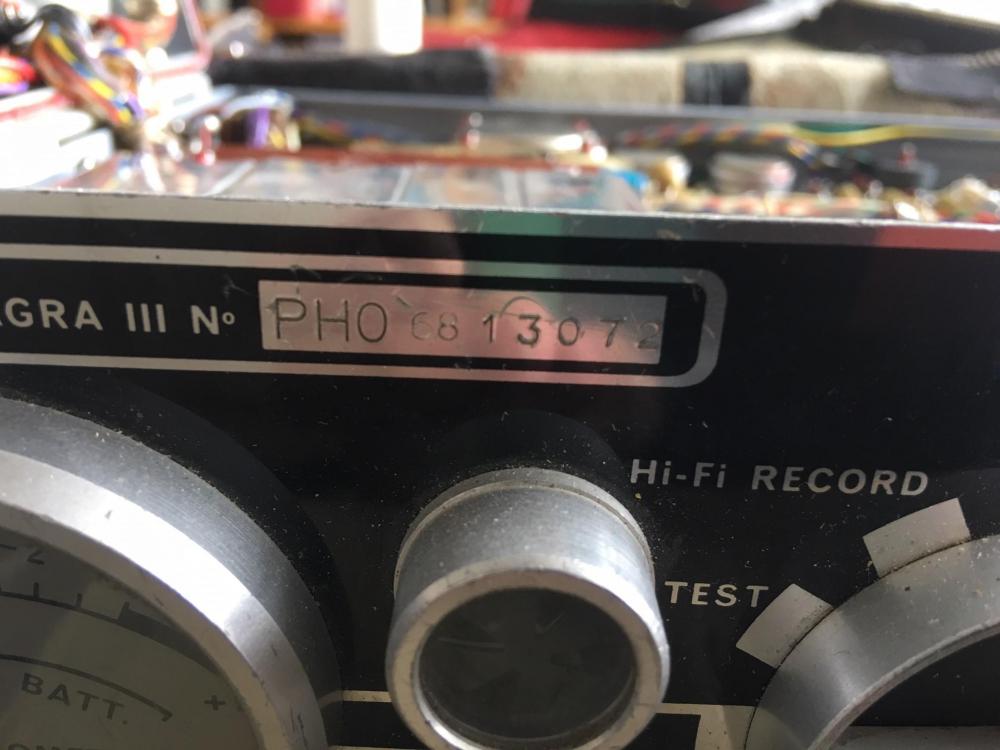
dela
Members-
Posts
124 -
Joined
-
Last visited
-
Days Won
1
Content Type
Forums
Gallery
Store
Everything posted by dela
-
I had some spare time today, so I thought I would also add some serial numbers for the Nagra III SN. collection... I have 5 fairly garden variety Nagra III recorders; if it is accurate that the first two digits show the production year, they are manufactured in 1962-1968. On the photos it can be seen how there are slight but noticeable differences. To sum up, the serial numbers for the recorders are: BH 62 1599 PHO 6813072 PHO 6710710 PHO 6710740 PHO 6711121 The main difference between the 1962 unit and the later versions is, that the pertinax (baked paper) boards are replaced by the much more stable fibreglass boards. A tiny difference is that the modulometer is a bit more robustly mounted than in the later units, where a more traditional meter is used. Could be caused by a change of supplier; the "new" type seems a bit simpler and thus cheaper. On all the Nagra III recorders (and actually all Nagra III recorders) Philips electrolytic capacitors are used. They tend to dry out over time, making it a good idea to replace them if the Nagra is to be actually used. But strangely enough I have never encountered a Nagra III that needed capacitors changed... The 1962 Nagra III is a bit special to me, because that was my first Nagra. A year after the next III came, then a Nagra IS, and from then on they just kept coming to me. I am sorry about the dirt on the 1962 unit; I hadn´t noticed that the semi-rotting bag had left such a mess...
-
Great machine! If you are not using the TC capabilities, you might completely disable the recording of TC, so that you don´t get any TC bleed into the audio. Normally it is not a problem, but if you can hear any TC at all, it is quite easy to disable it (i a non-destructive and reversible way). It is described in the service manual; tell me if you need a scan of it... I have not been polishing any lids myself yet, but a very knowledgeable german Nagra owner gave me a description of how to do it: "Also for clear lids I have the same results with "UNIPOL" and a very soft towel. This gives very good resultsHere is the link to Amazonhttps://www.amazon.de/Unipol-Metal-Polish-Pflegemittel-Metalle-1000ml/dp/B0056EW4IQ/ref=sr_1_1?ie=UTF8&qid=1504464910&sr=8-1&keywords=unipol+polierpasteI use a PROXON device to do the jobhttps://www.amazon.de/Proxxon-Winkelpolierer-WP-E-28660/dp/B00JVT00JM/ref=sr_1_1?ie=UTF8&qid=1504464981&sr=8-1&keywords=proxxon+poliermaschine" It is an excerpt of a mail, in the rest he says that the machine polisher gives a much better result, but if a towel w. polishing creme is used, be sure to do it slowly and always keep moving. And never press... But if you take it to Trew Audio, I am sure that you will get all your questions answered...
-
Actually there is a link between Nagra IS, me and Procol Harum: One of my DR Nagra IS recorders are from the collection of Anton Stormlund, who owns a large collection of Hammond organs. On a tour of Denmark, procol Harum (or rather: One of the incarnations of it) visited his exhibition and tested his instruments, including his huge theatre organ. It is indeed a small world...
-
A smart mod, but keep in mind that the Mac mini expects a supply voltage of 12V DC with possibly a quite narrow tolerance. So be very careful, if you want to run it directly on a battery supply, where the voltage can vary considerably.
-
This (rather blurry) photo is from a SNN currently on sale on eBay. It seems to have had the extra input connector installed as well, so it is probably a common mod.
-
I think (without actually having access to a SNST) that it is just a hole with an internal threading, possibly for an accessory. I have found a picture of a partially disassembled SNST where the mysterious hole is shown: http://www.alamy.com/stock-photo-nagra-snst-circuit-boards-nagra-snst-spy-recorder-35920311.html On that image, the inside part behind the hole looks identical to the parts behind two screw holes in the connectors, where they are used for fastening the male connector or accessory. My guess is that the Kudelski people of some reason put an extra fastening option on the SNST, in addition to the two connector locking screw holes. But that is just speculation...
-
It seems that the IS is quite popular at the moment; there are two up for sale on eBay and another one locally in Denmark. And interestingly enough they are all ex-DR... DR had a large number of them in use, and I think that a lot of them "disappeared" when they were phased out. I have heard numbers of app. 400 recorders (half on TV, half on radio), and in the Radio Denmark collection they only have 5-10 left. So it is not impossible, that I have more IS recorders than Radio Denmark itself... I have checked the two Nagra IS on eBay, and they are both quite nice. The one in JBonds post is a IS-TLSP, ie. it is prepared for pilot use. The other one is a bit newer, but without the possibility of upgrading to pilot use. The bag for the one in the picture is actually not an original bag (as stated in the eBay posting), but it is on the other hand a much nicer and better bag. After what I have heard, this bag was supplied to DR by the father of one of my former collegues; he had a quite well assorted company at that time. The real original bag is a rather boring beige thing, while this one is of much better quality. I have one of them, and it is clearly more attractive than the others. An interesting thing about the other IS on eBay is that the pictures in the posting shows a bottom view of the recorder. On the bottom side it has a label saying that this recorder is a replacement for another one, borrowed to DRU (probably Radio Denmark youth radio dept.) in 1994. This means that the IS, which was released in 1974, was still in active use 20 years later. Not too bad, I think. I was just about to write that they are both a bit overpriced, but when checking up on them a minute ago, I found that they were actually both sold. If the prices stay this high, I might not have to worry about my life in retirement (which is, admittedly, still quite some years out in the future).
-
I just got a Sony TC-510-2, and by a coincidence I found this thread about what the abovementioned recorder was to be used for, and how it was prepared for the Mindhunter intro sequence: https://www.therpf.com/showthread.php?t=282827
-
I worked on a film (Dear Wendy, 2004) where a SN was used in an abandoned coal mine in Germany. It (and a 16 mm camera) was the only recording equipment allowed to be used in the mine. Unfortunately I never had the SN "in real life", as the recordings were transferred to DAT in Germany. So the first Nagra I ever encountered, I never actually saw... Regarding the SQN3 + SN combo, the SQN3 was actually designed to be used in conjunction with the SN (as an early mixer/recorder unit). SQN then found out that the mixer on its own was a winner, and the rest is history.
-
I was lucky enough to start collecting before the prices started skyrocketing... And, not least, have the luck to know a lot of people who has used Nagras, and who more or less have donated Nagras to me. So now I have 26 machines, each with a history from different corners of the (mostly) danish film and broadcast world, all maintained but not so polished, that they hide their original use. But it is getting harder and harder to get new machines for a non-ridiculous price, as most potential sellers follow the eBay "Buy Now" price... It is typical that whenever an expensive Nagra is sold on eBay, more sellers follow tgrying to sell the same type recorder for that same high price. Which seldomly works out, indicating clearly that the market for Nagras is quite limited and easily saturated. A year ago Nagra IS machines hit a peak, with decent condition machines were sold for up to 1200-1400 USD. Now I could buy one locally for app. 300-500 USD, also in fine condition.
-
WiFi and my mid 2012 MacBook Pro
dela replied to Jim Rillie's topic in Macs... and the other computer
It definitely sounds like an antenna problem... The annoying thing about that is that the antennas are built into the screen base, so they are not easily accessible... The antennas can be replaced without damaging the screen, but I don´t know if Apple supplies it as a separate spare part. So Apple may see replacing the entire screen as the only solution.. If you can find a scrapped screen, the antennas can be moved to your screen, it just takes a bit of finesse (and perhaps help from YouTube) to do it. -
WiFi and my mid 2012 MacBook Pro
dela replied to Jim Rillie's topic in Macs... and the other computer
If you click on the WiFi icon in the top menu while holding down the Alt-key, you will get a reading of a range of parameters of your connection. You can check your RSSI (received signal strength); on my connection (with app. 5 m to my Airport Express base) I get a RSSI of -59 dBm. If your RSSI is significantly lower, you might have a problem with either the WiFi card (easy to fix) or the antenna in the screen base (not easy to fix). It might still be a software problem, but in this way you can start by eliminating hardware issues... -
1/4 Track Playback Head On A Nagra IV-S
dela replied to Nicholas West's topic in Technical Reference
Here is a guy who did replace the pilot head with a quarter track head: The tricky part would be to find a head that is an exact physical match to the original Nagra head. It doesn´t look like a Kudelski head viewed from the front, so he might have fitted another type head in a Kudelski head casing. Which in itself is quite a feat... In the commentary field someone asks about the make of the head; there is no answer, but a direct question to the guy might give an answer (which I am eager to know...) -
I know of a place (in Copenhagen), where they have a NOS wide track record head for the IV-S. Unfortunately not a corresponding playback head... Then you just need the IV-S, but that might well be a standard 2mm track width machine, which is (relatively) easier to find.
-
The pilot and non-pilot versions of the IV-S came out at the same time; they were just two variations of the same machine. So the non-pilot wide track IV-S also has the NRS option... The only reason the track width was reduced, was to allow for a center track with the pilot information. It was important not to mix tapes recorded on wide- and narrow track recorders, so often non-pilot recorders were fitted with narrow track heads to avoid incompatibility. Sometimes non-pilot IV-S recorders are described/sold as very desirable and better for music recordings, but that only goes for wide track machines; if it has narrow track heads there are no difference. As for the sound quality with NRS, I guess that a lot of factors play in, f.ex. the design of the specific noise reduction system and the calibration of the system/recorder. In theory the noise floor will be lower with a NRS, but it also adds a lot of circuitry to the signal path. So the resulting sound quality depends on the actual setup...
-
Chris: If you need some info on the disconnected things, fortunately the schematics are included in the manual for the Nagra III: http://lcweb2.loc.gov/master/mbrs/recording_preservation/manuals/Nagra III Instructions Manual.pdf It is quite a while since I last looked at my Nagra III machines, but if you are not sure how to connect the motor and the meter, I can check up on it and send you some pictures of the cabling. The III can be a bit tricky to navigate in, because so much of it is enclosed in shielded modules... As a collector I obviouslys like machines in good condition, but it is also fun to have a challenge once in a while. I have a water damaged 4.2 that I have spent a lot of time fixing just for the fun of it, and it is very satisfying to have fixed all the issues. It might not be mint condition, but still it has its history, and you get to know you Nagra really, really well by nursing it back to life.
-
What if audio post company does not have the software?
dela replied to soundhound82's topic in General Discussion
I (as a primarily video post person) actually liked Audiovision, so it warms my heart that it was used and considered a useful tool by many... -
What if audio post company does not have the software?
dela replied to soundhound82's topic in General Discussion
I shudder to think how this combined audio/video application would be implemented... Trying to make an application that would combine two very different worlds and work methods into one process would, in my opinion, inevitably infuriate either audio- or video users (or both). It would have to incorporate all the different processes developed over decades, but squeezed into one single GUI and methodology. Avid once had the Audiovision, which looked like an early attempt to make a combined audio- and video workstation, but in reality it was little more that a Media Composer with some glued on ADR tools. It never really took off, and I suspect that one of the (many) reasons was that sound people not necessarily want to be pushed into editing audio like video; they are two very different processes. I think that Blackmagic attempt to make this combined application could go well, in that it would be a great (free) tool, that could incorporate both video and audio, but it is also a risky move. Resolve was primarily made as a video conform/grading/finishing tool, and if this core functionality is in any way compromised or cluttered with rarely used editing features, it will scare away high end users. And I am absolutely sure, that it would attract a sizeable segment of prosumer users, but it will not be attractive to high end audio/video editors. And, as the Final Cut Pro 7/X transition disaster showed, users can abandon an otherwise established platform almost overnight if their workflows are disrupted and neglected. That being said, I think that Resolve is a marvellous tool, and that Blackmagic should be praised for having a vision about creating a completely integrated product range of relatively cheap hard-and software. But, apart from the grading/finishing components, still a work in process and not necessarily ever a great editing tool. -
18V should be just fine. The Nagras are normally rated to work on 11-35V supply, and 18V is actually the voltage of a set of (new) batteries.
-
I have just checked up on the pilot system in the 4.2, and I have a couple of comments (but not an answer as such on why the pilot indicator turns off during record): Your 4.2 has three options installed: 1) The QGX-50 crystal generator 2) The QFM-50 frequency meter option. It is that circuit that measures the frequency of the incoming og played back pilot signal. If the needle of the modulometer is stationary in the middle at 0% (when in the Frequency setting), the pilot frequency is exactly 50 Hz. If you go to playback, the pilot frequency is compared to the reference frequency. A difference between these two will result in the meter needle oscillation. 3) The QSLI synchroniser. This circuit will compare the reference frequency with the pilot signal. And here is a catch: If you select Playback without speaker on, the QSLI is not active, and the needle will oscillate, indicating that the speed is not spot on according to the pilot signal. When you go to Playback with speaker on, the QSLI will be engaged, and the meter should remain stationary, indicating that the QSLI has succeeded in regulating the speed to compensate for the pilot frequency difference. So in theory when playing back your old recordings, the needle will oscillate in Playback with no speaker and be steady when playing back with speaker on. I hope hat it clarifies the workings of the system a bit; I will ponder over the service manual when I get the time and try to figure out why the pilot indicator goes off during record. It might not be a fault...
-
You could do that, if you could get the non-pilot heads. I am not certain if you need any electrical adjustments with he new heads (I would imagine not); the actual replacement of the heads is quite easy. Of course you need to make a complete readjustment of the heads, but that is what service manuals are for. I know a place that have a recording head on stock, but I don´t know the price of it... I remember that you have the Harvey modded IV-S... I would really love to have such a machine, so personally I think it would be a shame to cripple the TC capability to get a marginally larger S/N ratio. But then again, I am just in it for the machines, not to really use them for recording. I just checked with a couple of my 4.2 recorders (I know that at least one of them has problems with the pilot system...), and the pilot indicator should remain on when going into record mode.
-
Unfortunately no; the TC track lies in the middle of the tape between the two audio tracks, so if there is no wide guard band between the tracks, the TC signal will overlap the audio tracks. I don´t know that much about the Harvey TC implementation, but that also relies on a middle track...
-
I am pretty sure that if you remove the return spring, the braking function will be really bad... If the spring is not pulling the roller outwards, roller will move inwards (and release the brake) with even a very low tape tension. If adjusting the spring does not work, you might try to dampen the return spring with f.ex. a bit of soft foam tightly around the spring (since the diameter is too small for putting the foam inside it).
-
Oops... I just checked with a scrapped 4.2 and discovered that I had mistaken left from right. The clutch is on the right reel, on the left reel the regulation is made with an adjustable brake. But the principle is the same, and actually the brake felt is a bit easier to check and replace on the brake than on the clutch system. But sorry about the confusion anyway...
-
David is right that it is a common problem with the portable models, but unfortunately the service manuals are not really informative about how to solve it... The wobbling/oscillation og the roller is caused by the rather ingenious mechanical feedback system, where the left roller position is adjusting the left spool clutch. When the roller moves inwards (tape tension increases) the clutch is loosened (spool torque is decreased), because the movement of the roller is coupled to the clutch, using a metal arm between the two. It works really great if the clutch is working, but if f.ex. the clutch gets "sticky", the torque adjustment is not perfectly smooth, and you get the oscillation. The good thing is that it is not really serious (it usually goes away if you manually holds the roller, corresponding to dampening the mechanical feedback system). In my IV-S TC, which had been inactive for many years, it even disappeared by itself after a bit of use. Getting rid of it involves taking apart the clutch and replacing the grass og the greased felt in the clutch; it can (probably) be done, but it is not for the faint hearted på apply new grease, as it is a one-way street: Once the original grease is not there, the regulation might get even worse... But it will probably be a good idea to start with making reversible changes, so adjusting the tape tension (on the adjustment screw on the clutch arm) might be a good start.


